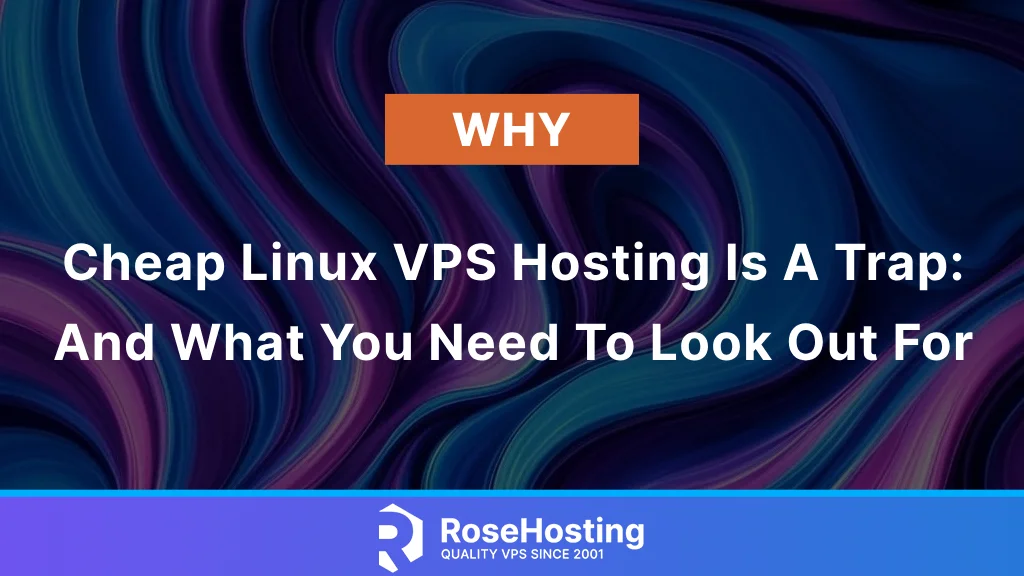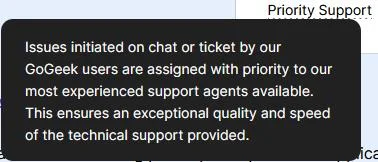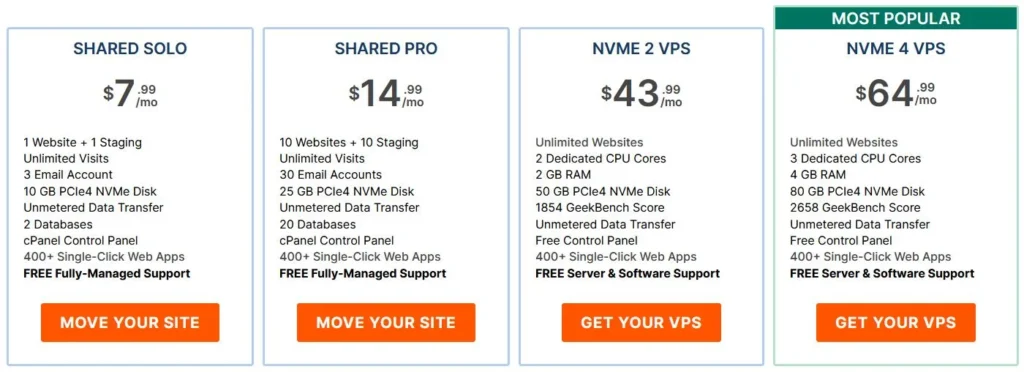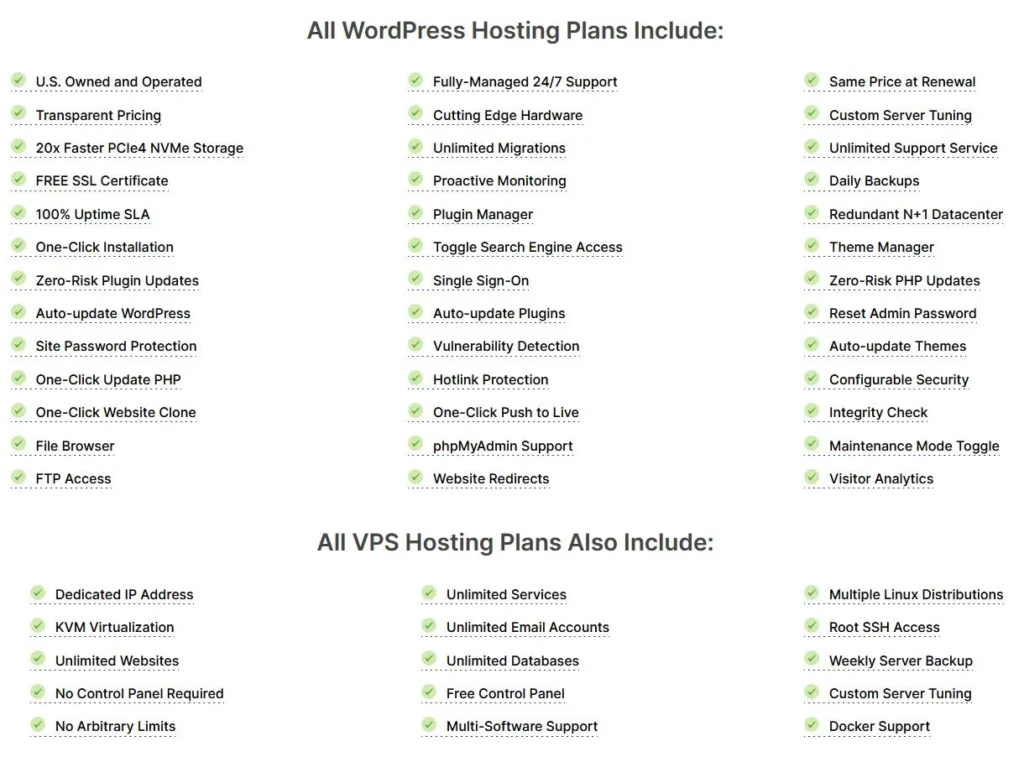
Cheap Linux VPS hosting is an all-too-common and alluring trap. It is so common precisely because it is so attractive and effective. The promise of hosting your website or email for a handful of dollars per month is fantastic on paper. This is even more enticing when such offers are made by big-name brands trusted by millions who came before you. They surely wouldn’t burn millions of loyal customers that came before you for a few hundred of your bucks. Cheap or affordable is typically a good thing for a consumer. You get the same product or service for less money. Fantastic! Right?
Any server almost always functions under the same principle as any other server. It’s a machine with a CPU, RAM, and storage. You upload your website files to it, and you’re good to go. Unfortunately, the sad reality of cheap hosting is riddled with costly traps and misleading information for the uninformed. It would be great if the product or service you received were the same, but they’re not. Not by a long shot. It would be like comparing a typical functioning house to a tent. Both will keep the rain off your head, but there’s a world of difference in utility and value. Worst still, that’s not a bug. It’s a highly engineered feature! In fact, much of the industry is built around these very dodgy pricing models.
Table of Contents
How Cheap Linux VPS Hosting Works
Every company needs to cover expenses and make at least some profit to stay in business. This is common sense and applies to all industries. Cheap hosting offers servers below purchase value, necessitating companies to cover those expenses via investment capital or cutting corners. The former means they’ll rely on making a quick buck to repay their investment and make a profit for their investors. This of course leads to increasing costs for their existing clients—you!
The alternative is even worse for the consumer. Cutting corners leads to many invisible problems and often goes hand in hand with irresponsible, quarterly, profitability-driven practices. Companies overprovision their significantly outdated hardware, impose arbitrary limitations, use AI bot support, and implement hidden fees. Needless to say, constant downtime with such providers will destroy your SEO and negatively impact any online earning potential. This is especially true if your website is a key cog piece of your business, such as e-commerce.
So, what are some key things to look out for, and how can you get around these problems?
The Traps of Cheap Hosting
Long-Term Lock-In Contracts
Getting a 10% discount on long-term prepaid contracts is reasonable. If you prepay for a year, instead of using part of your payment on marketing costs for your server, the provider passes on that discount to you. As that particular server is already covered, the provider doesn’t need to market it to another person. Makes sense so far.
However, getting a discount of 40% or more, especially a ridiculous 80% or more, is financially unsustainable. This indicates that the regular price is either ridiculously overpriced or you’re not getting what you’re being promised. More often than not, it’s both.
Worse still, once you lock yourself into a multi-year contract, you prepay a large sum now to make an overall saving. If you exceed your allocated plan resources at any point in time, you risk throttling your server or even outright suspension. In that case, any potential savings you’ve made by paying up front become an additional expense. You’ll have to pay even more to keep your site operational and on a far bigger price plan this time. When your site is your source of income, and it’s being held hostage, you tend not to take your time to look for alternatives.
Price Change on Renewal
On the back of the previous point, big discount lock-in contracts are almost always paired with a price increase on renewal. The initial cost is reduced, so you wouldn’t bat an eye even if the servers and service are horrible.
Then they use several downright nasty tricks to effectively swindle you out of your money:
- Plans can and will renew before the actual renewal date disclosed to you. This can happen up to 15 days prior in some instances.
- The plan will renew for the full term you originally signed up for. So, if you originally signed up for a three-year plan, you will be pre-charged for three years.
- The plan will renew at their non-discounted rate, which you previously got at an “80% discount” or more. You can expect at least a five times higher surprise cost on your next credit card statement.
- But it’ll be significantly higher than that for long-term plans, as certain providers increase their “base price” regularly. In some instances, costs double in a matter of a few years. If you’ve been unfortunate enough to renew at that stage, multiply your initial cost by a factor of 10.
- The worst part is that you’re no longer eligible for a refund because you’re not a new customer.
This case might sound cherry-picked or hand-crafted, but it happens yearly to millions of customers across many hosting providers. I should know, as the above example is precisely what happened to me a few years ago — along with many others, as my research would later reveal.
Price Change on Renewal Broken Down

Here is an example of a popular host’s price structure. A common practice in hosting, it would be considered a scam in many industries. Providers advertise unrealistically cheap $2.99 per month prices. Hooking you with unsustainable discounts of 80%, after which hidden costs and asterisk traps begin.
The $2.99 applies only to annual prepaid plans. That means you’ll pay $35.88 today for the cheapest plan for one year. Your plan automatically renews before expiring, charging your credit card $215.88 for another year. So, you’ve effectively paid $10.49 monthly for 24 months for the bottom-of-the-barrel, super-slow, unmanaged shared hosting.
For multiple websites, the middle plan has twice the storage space and ten times the visit limit. Coincidentally, limiting the number of visitors your site can serve is like limiting the number of customers who can walk into a shop you rent.
Being optimistic about your future site growth prospects, you compare the $4.99 price tag with their $7.99 GoGeek plan. Unlimited websites, 40 GB of storage, and 400,000 monthly visits sound like plenty for $7.99. What’s more, you get more features than in the other plans.
Before you know it, you’ve clicked on an ad promising $2.99 hosting, yet you’re now purchasing a plan advertised on their site at $7.99. Again, this only applies for 12 months and has to be prepaid. Your bill for today is suddenly $95.88, which is much higher, but you justify it to yourself as an entire year’s worth of costs. You bite the bullet and order the GoGeek plan, only to find a $635.76 charge on your card less than a year later. Their renewal plan cost is $44.99 when prepaid for an entire year. Combined with your first “discounted” year, you’ve effectively paid $26.49 monthly for an unmanaged shared plan with considerable limitations.
Why Cheap Shared Hosting is Especially Bad
Cheap Linux VPS hosting is a trap. Cheap shared hosting is significantly worse. Unfortunately, it’s also more profitable and far more common. In our previous example, you may have noticed that all the features have dotted underlines. Hovering over these shows an expanded description. The two most interesting are the “Highest Tier of Resources” and “Priority Support”.

This means that even though you’re already restricted on a shared plan, they purposely choose to tack on additional limitations. Firstly, you’re packed in with way too many users who can and will eat into your resources. Then you have additional throttling and constraints on your hardware, which is almost guaranteed to be very outdated. Reselling you pennies-on-the-dollar old hardware is the only way these providers can afford to offer such massive discounts.
This, of course, is all on top of your existing arbitrary limitation of how many monthly visits you can have. Now you’re stuck on old equipment. You’re jam-packed on a server with too many users, slowing down your websites. You’re limited to running basic websites only. You have arbitrary limitations based on your site’s success and further artificial throttling, unless you pay for their highest tier plan!

Then there’s the customer support, or lack thereof, unless you’re on the highest tier plan. Stating that they have tiered support means you’ll either be redirected to cheap outsourced barely-knowledgeable “support” or be thrown into the AI chatbot pool. Once you’ve wasted enough time, you might get onto a system admin who can resolve your issue if you’re lucky. Considering this is also unmanaged hosting, you’ll likely have to pay for anything beyond a simple answer, where you have to do everything yourself anyway.
Cheap Unmanaged Shared Hosting vs Managed Linux VPS Hosting
In the prior example, you can’t see that the renewal price of $44.99 asterisk indicates only annual prepay. The actual month-to-month price is $49.99. Looking at things through a long-term lens, this price point is not cheap by any stretch of the imagination. When we say look for value rather than focus on cost, we must analyze what you get for your money. Firstly, a key thing to remember is that for $50 per month, you are getting an unmanaged shared server. Then there’s the myriad of issues we already outlined.

Alternatively, you can get managed shared WordPress hosting for significantly less money. Better still, you can get managed VPS hosting for less money than the previous top-tier plan. Interestingly enough, you’ll get substantially more value on both options. While shared is restricted in the number of sites and is, in theory, overprovisioned by the very nature of shared hosting, as you’re sharing the same server, everything else is miles ahead. We limit how many accounts we can place on a single server, making you less likely to have any issues. You’re granted a free staging server for each website you have. We also only use the latest gen hardware, including NVMe storage, impose no arbitrary limitations, and offer fully managed support that includes installations, fixes, and backups for you. On a VPS, you get so much more. See for yourself.

So What Does This Mean?
Let’s simplify this in an easy-to-understand format:
| RoseHosting NVMe 2 Managed VPS | Competitor GoGeek Plan | |
| Regular Monthly Price | $43.99 | $49.99 |
| CPU Cores | 2 Dedicated latest gen Xeon Gold cores | Shared outdated unspecified CPU |
| RAM | 2 GB DDR5 server-grade ECC RAM | Shared unspecified commercial-grade RAM |
| Storage | 50 GB PCIe 4.0 NVMe drives | 40 GB unspecified slow SSD |
| Support | Instant chat true-fully-managed support | AI Chatbot redirects you to knowledgebases to do it yourself. Tough luck if you’re technically inexperienced or need something advanced. |
| Hardware | Dedicated, enterprise-grade latest-gen hardware | Shared, overprovisioned, commercial-grade, outdated equipment |
| Access | Unrestricted root access with or without a control panel (your choice!) | Restrictive control panel |
| Migrations, Installations, and Optimizations | Free, unlimited, anytime, and forever with hand-tweaked optimizations and integrations catered to you. | WordPress-only automated plugin |
| Uptime Guarantee | 100% SLA with 1,000% Money-Back | 99.9% (industry-standard) counted on an annual basis, with no money-back guarantee |
| Arbitrary Limitations | Absolutely none. Ever! | ~400,000 Monthly Visits across all sites. |
| What Support Does | Web server installations, website and software migrations, software/package/plugin installations, configuration, and updates, backups, recoveries, reverse proxy and HTTPS setup and configuration, PHP configuration, .htaccess updates, database optimizations, proactive monitoring, diagnosing and fixing failing services, email server installation and configuration, brute force prevention, firewall setup, vulnerability patching, offiste backups third-party service setups, pagespeed optimization, patiently answering your questions while fixing your issues, even fixing server mistakes your team may have made. Everything short of coding your sites. | Lets you figure it out on your own. |
| Legacy Customer Price Increase | Never! The price you pay now is the price you’ll pay for the lifetime of your server. | Let you figure it out on your own. |
Why Would Anyone Go for a Worse, More Expensive Shared Plan?
Sadly, according to their advertising of this “popular” hosting provider, they have “millions of happy customers.” Their bread and butter is their shared unmanaged hosting, and most people will be drawn in with their $2.99 price offering. The only benefits of shared hosting are the low price point and lack of need for complex server management, but unfortunately for their millions of happy customers, neither of these is true.
They spend money on marketing and affiliates and use questionable practices, such as moderating the most popular hosting Facebook groups. This enables them to quickly remove negative feedback about their service and any positive feedback for their competitors.
Legacy Customer Price Increase
A cardinal sin of hosting is focusing on selling servers to new users at the expense of existing customers. Nothing screams that a hosting provider doesn’t care about you more than increasing prices for legacy customers. This is their way of letting you know that they don’t value your loyalty at all. They only look at you as a sale to close and then focus on acquiring new customers. If a hosting provider doesn’t show loyalty to their existing customers, you can be sure they’ll treat you the same once you sign up.
Loyalty programs are nice, but the most crucial thing to consider is that your hosting provider never increases prices.
Managed vs Unmanaged Hosting
We have written multiple guides on true, fully managed hosting and the benefits of exclusive level 3 support. No, AI chatbots. No outsourcing to untrained overseas support that will put you on hold. If your patience holds out, you’ll likely only be pointed towards a knowledge base to “fix it yourself”.
Managed support hosting can be viewed as the default entry point for small businesses. You get reliable, secure, quality hardware; additionally, you can save money on software subscriptions you already use. With email alone, you can scrap that entire cost by migrating away from email hosting services such as Google Workspace. That’s a minimum of $7 monthly and $22 monthly for the feature-rich Business Plus plan. This is $7-22 per person per month. Even the smallest business will typically have five or so employees, though this cost can quickly balloon to extreme heights. For the price you pay for two to three employees, you can get hosting for your websites, email, and many other services. Including password managers, document and file sharing, voice and video chat, and other crucial tools, you can make significant monthly savings.
The only downside is the lack of support each service can provide, but with managed hosting, that becomes a non-issue. You get better support for all those services than you would for any of them.
Why is Cheap Shared and Cheap Linux VPS Hosting so Popular?
Hosting is a business. As with any industry, it can be family-operated, corporate board-led, or anything in between. Therefore, providers can either prioritize a long-term sustainable approach or have a quarterly profit-focused business model. Most big-name providers are corporate equity-owned ventures or started small and eventually got bought out. As such, they prioritize quarterly fiscal targets over everything else, making short-term profit their primary goal. Unfortunately, this is true, even at the expense of long-term gains such as significant customer churn. So long as the earnings for this quarter are strong, any customer dissatisfaction is a future problem that can be solved with another discount and new sales.
As you can see, the sad reality is that existing customers are ignored as new “sales” will always be the priority. But why do new customers keep coming if the truth is this bad? It’s partly because this industry has always been exceptionally good at not telling you things that make a big difference. Exact component specifications and generation make a massive difference in performance, or replacing support with AI Chatbots to cut costs. As competition within the industry increased, more providers turned to increasingly underhanded tactics to trick new customers into signing up with them. Without naming and shaming specific companies, here are a few reasons why people like you keep falling for these tricks so efficiently:
Cheap Linux VPS Hosting and Cheap Shared Hosting Tricks
It is crucial to understand that affiliate programs run much of this industry. Many big-name providers offer two affiliate programs: one for standard bloggers and a special rate for household-name brand sites with viewership in the millions. These tech news industry giants bring a history of authority and brand trust, so affiliate programs throw more money to get them to write seemingly impartial reviews. Sadly, these reputations have been widely abused for financial gain by the affiliate and the provider since at least the GFC.
Top 10 Sites
Forbes, Mashable, Wired, PCMag, and many others. Once reputable household names began utilizing affiliate programs to increase profits. When quarterly earnings weren’t as strong, many such companies lowered the bar for what affiliates they accept to increase revenue. As a result, many hosting providers that aren’t exactly the best caught on to that with a slightly more lucrative offer, and they could get a placement on a top 10 list. Soon enough, every top 10 list became a pay-to-place list. The more you paid, the higher you ranked. Smaller ranking sites naturally followed suit to make a profit as well.
Ultimately, you’re left with a “top 10” list of highest bidders, rather than the top 10 best hosting providers. Naturally, the users tricked into going with these suffered the most.
Review Sites
Review sites faced similar financial burdens. They built a large enough number of reviews but couldn’t find a way to monetize them, so they offered premium memberships. In addition to paying for fake reviews, which are rampant in many industries, certain hosting providers started to pay to remove negative reviews. This was one of the advantages of such premium memberships.
Once the review sites saw that certain providers would pay to manipulate their reviews, they started reaching out to everyone else. The more premium providers manipulate reviews, the more income they make. However, if your profile had a good enough natural review score and you didn’t need to pay, they could and often did resort to taking your reputation hostage. There are numerous cases where legitimate positive reviews would disappear for non-paying companies, with the reasoning of fake review removal.
This meant cheap hosting providers could remove negative reviews and add fake positive ones, increasing their overall scores. Meanwhile, quality hosting providers that didn’t add fake reviews would have their best reviews taken down, lowering their overall score. As a result, both cheap and quality providers would be rated relatively closely, but one would be presented as significantly cheaper.
Unbiased User Group Infiltration
Savvy shoppers’ final research destination is turning to unbiased review sources. These are social media sites, forums, and user groups where actual people can give their honest opinions, where financial incentive doesn’t play a role. Most of us expect raw and unfiltered feedback in places like Facebook groups, Reddit, hosting forums, and similar. Combining this information with review sites and top 10 listings gives a clearer picture of how products and services stack up.
Unfortunately, once again, certain hosting providers, being aware of this, infiltrated these Facebook groups and forums. As affiliate links are easily visible and reputation is lost quickly in such places, they resorted to flat fee payments for group admin and moderator rights. Several individuals who work for these companies or are ex-affiliates of those providers have detached themselves from the brands and moderate those groups. They employ shadowban tactics, post editing, and guerrilla promotions.
The Cocktail of Cheap Linux VPS Hosting Cross-Promotion
The final nail in this coffin? The companies that utilize one of these strategies are the same ones that do them all. They spend excessive money on marketing to give their brand more visibility and recognition. Then they further overspend to rank in the top 10 listings and review sites. Finally, they pay people to manage this entire process and infiltrate forums and user groups where they spend time removing any tarnish from their brand. Certain brands have even become infamous for bullying bloggers and sites that reviewed them negatively with legal threats. That’s an additional cost for their lawyers.
As you can imagine, this is a significant cost, and that money needs to be recouped to retain profitability. Outdated equipment, overprovisioning, hidden fees, AI chatbots, arbitrary limitations, lock-in contracts, price increases, and many new customers.
Those are the unspoken secret traps of much of the hosting industry. The stronger the branding, marketing, and affiliate programs, the more likely the company is to use these shady solutions.
The Single Solution to Cheap
There is one way to avoid the cheap Linux VPS hosting and cheap shared hosting trap: to look for value. While this can be difficult and time-consuming, it will save you both money and patience. We cannot speak for the quality of other providers, and you need to do your legwork when doing the research. Crucially, though, look for signs of value and how open the company is. At RoseHosting, we see ourselves as the Saints of Hosting, and each decision holds to that mantra.
As a privately owned company, we have no external investors and no debts. We can afford to work a little harder, wait a little longer, and set our prices a little lower if it will mean happier long-term customers. We have no shareholders or board of trustees to answer to each quarter, so longevity is the target. Finally, we don’t need to spend millions on needless advertising to showcase artificial growth. Our time and effort are spent on making our clients happy.
We work towards steady and incremental growth rather than an exponential explosion, which would severely limit our capacity to provide the same quality of equipment and support to our newest customers. Our customers mean everything to us, and we’re unwilling to cross that line for a quick buck. It’s a question of pride in what we do.
Finally, since the beginning, we have prioritized a quality hosting experience with high-quality support over everything else. This quality over quantity approach means that we don’t use tricky fine print or exclude features, which will become a sore point in the future. Instead of competing on price, we pride ourselves on offering you the best value hosting on the market.
Cheap Linux VPS Hosting is anything but cheap. Get the best value Linux VPS hosting instead.